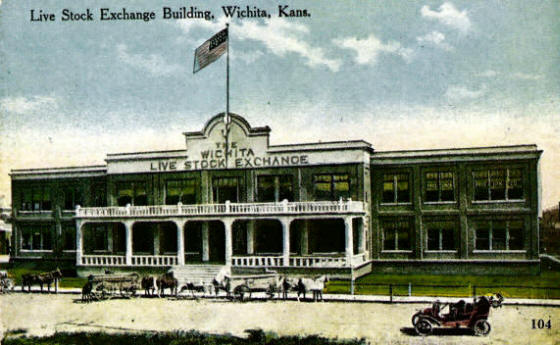|
From glory days to junk yard
|
THEN: An old postcard view of the Wichita Live Stock Exchange located at 702 E. 21st Street. |
 |
||
|
NOW: After demolition in 2000, nothing remains of the Wichita Live Stock Exchange to mark that it ever existed. (Photo credit: dc & vc) |
|
Generations of movie and TV viewers have known Wichita as a "Cowtown." And it was the cattle trade that was the driving economic force of our young city, as ranchers would drive their herds across a ford of the Arkansas River and down Douglas to the first cattle lots, just east of the new railroad line that would carry them to Kansas City, Chicago and beyond.
JíNell L. Pate says in her 2005 book, Americaís Historic Stockyards: Livestock Hotels, "The entire town of Wichita could be termed a stockyards as early as 1872 when the two-year-old settlement and trading post on the Chisholm Trail saw its first railroad, the Santa Fe, arrive. Citizens also worked to get the Western & Southwestern Railroad to connect to the Santa Fe and others. After its first year as a railhead, Wichita received 70,000 head of cattle worth at least $2 million."
The subsequent history is covered not only by JíNell but also both the Wichita Beacon and Wichita Eagle as well as in Peerless Princess of the Plains.
In January 1887 the Wichita Union Stock Yards Company was formed. They opened for business Oct. 18, 1887 on a 28 acre tract along Emporia Avenue around 18th Street. At the close of its first day of business the entire stockyards complex burned to the ground, destroying two carloads of cattle and 100 tons of hay.
JíNell says the very next day "local men pledged enough money in 45 minutes to begin rebuilding."
That second stockyards opened Jan. 1. 1888. However they soon moved their location to just north of 21st street when meat packer Jacob Dold agreed to build a plant on 21st Street. This time they built not only lots but a Stockyards Hotel and an Exchange Building, in the middle of the stockyards.
A second great stockyard fire occurred June 2, 1904, destroying both the yards and the hotel. JíNell says, "After rebuilding, the company in 1906 gave meat-packer Cudahy one-sixth of the stock in exchange for a guarantee that Cudahy would continue to operate a packing plant in Wichita for at least 10 years. . . Cudahy kept increasing its percentage of ownership. By 1917 it owned one-third of the $1.4 million stockyards shares."
In April 1909 the Union Stock Yards Company decided to build a new Exchange Building and move the old exchange building and hotel to the south side of 21st street, where they were joined together and opened as the Stockyards Hotel. That building, which also housed a restaurant famous for the best steaks in town, operated until it was destroyed by fire in the late 1960s. Those buildings were razed in March 1972 to make way for the North Industrial Park.
The new Livestock Exchange Building, at 702 East 21st Street, was completed in a year. This 40-office, two story masonry building is the structure which most long-time residents of Wichita remember.
Those who simply drove by might have been impressed with such a dominating Ė and white Ė structure in the midst of smelly packing and rendering plants.
Those who actually entered the building were usually impressed and even amazed. The insides seemed filled with white marble, dark wood and glass. It housed 15 livestock commission firms, a national bank, stockyard company officer, the Wichita Terminal Railway Co. and branch offices of the packing houses.
Two tile mosaics greeted visitors. One was a 40-inch by 45-inch bullís head on the first floor. The other, on the second floor, was a 4-foot by 6-foot section of tiles that said "Market That Satisfies" and was surrounded by the heads of a cow, horse, pig and sheep.
Sierra Petroleum Company purchased the Wichita Stockyards in 1972. By 1975 Sierra had purchased the last commission houses, and private treaty sales were virtually abolished. Livestock auctions continued for a while, but Sierra Petroleum shut down the stockyards on Aug. 1, 1980.
Before the Exchange Building was razed, in February 2000, HPA purchased the two mosaics.
HPA president Greg Kite told Beccy Tanner, in a Feb. 2, 2000 Eagle article, "We will put the tiles in storage along with the Allis Hotel stone we saved, then we will have a permanent display place for a lot of stuff. We have an enormous amount of material we can put on display."
10/08/2009